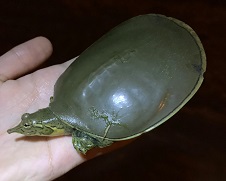 |
Pallid Spiny Softshell Turtle Range Map
|
|
|
 |
 |
 |
 |
 |
 |
 |
Pallid Spiny Softshell Turtle Hatchling

|
|
|
 |
 |
 |
 |
 |
 |
|
Pallid Spiny Softshell Turtle (Apalone spinifera pallida)
Description: Like most trionychids (softshell turtles), Apalone spinifera pallida (Pallid spiny softshell) lacks a hard shell and has a round, flattened, leathery carapace (upper shell). This turtle has a long neck and a snorkel-like, elongated snout with large nostrils containing ridges that extend from each septum. The carapace is an olive to light brown color. Juvenile Pallid spiny softshell have small white spots on the carapace that become less distinct or are absent anteriorly, however, some juveniles lack the distinctive spotting pattern on their carapace all together and are more uniformly tan or brown. The white spots of adult male Pallid spiny softshell are ringed with black, and males retain juvenile markings, while female markings become blotchy grey, olive to brown color with age. There is no distinct border to the carapace of this subspecies. Similar to the Eastern spiny softshell, the defining spine-like projections on the front of the shell behind the head along the anterior edge of the carapace called tubercles, are cone-shaped in Pallid spiny softshell. Pallid spiny softshell have two prominent black-edged, yellow stripes on each side of head and neck. The feet are fully webbed, clawed, and have a mottled coloring with black and yellow streaks.
Habitat: Apalone spinifera is an aquatic turtle species that prefers highly oxygenated rivers, but also inhabits creeks, canals, impoundments, lakes, and oxbows; especially those with a soft sand or mud bottoms. Sandbars or mud flats are important habitats and are used for basking and nesting. This species is often seen openly basking on logs or floating along the surface but will also spend some time buried in soft sediment with only the head protruding. While submerged, this species may supplement respiration through gas exchange across the skin and can remain submerged for upwards of 20 minutes.
Range: The range of the Pallid spiny softshell (A. s. pallida) is in the Red River basin, west of the Mississippi River in central and western Louisiana, southern Oklahoma extending to the Texas panhandle, as well as south of the Red River Drainage in east Texas extending west and south in the Brazos River drainage.
Diet: Predominately carniverous. Eat insects, crayfish, worms, snails, fish, frogs, tadpoles, and reptiles. Both actively hunts its prey and sits still to ambush passing prey. May also scavenge its food.
Reproduction: Male spiny softshell mature around a 4.5 ounce body weight while females mature around 15 kg. Females lay 4 to 39 eggs per clutch, with an average of 12-18 eggs. Nesting occurs during late spring and throughout summer, nests are excavated in soil exposed to sunlight, often in close proximity to water on nearby sand or gravel bars, however, nests can be placed further away from water depending on the availability of ideal nesting habita. Incubation lasts 2 to 3 months (dependent on ambient conditions), and unlike the majority of other turtles, the sex of hatchlings is determined genetically rather than by temperature, producing clutches with similar proportions of male and female hatchlings. Female spiny softshell become sexually mature in 4 to 5 years.
Status: Because A. spinifera respire aquatically with pharyngeal gill slits and cloaca, they are vulnerable to Rotenone, a chemical that is used to kill unwanted fish. Rotenone hinders oxygen absorption and many soft shell turtles are now gone from Rotenone contaminated waters in the Great Lakes. Habitat fragmentation and shoreline development continues to threaten nesting sites. Along with other turtles, A. spinifera is hunted or shot for "fun" and human consumption. Eggs, hatchlings, and juveniles are threatened by various human activities and vulnerable to predators such as raccoons, foxes, and skunks, all of which thrive in areas of human development. They are not listed as endangered, vulnerable, or threatened by the IUCN, CITES, or the U.S. Endangered Species Act.
»» Kingdom: Animalia - Animals
»» Phylum: Chordata - Chordates
»» Subphylum: Vertebrata - Vertebrates
»» Class: Reptilia - Reptiles
»» Order: Testudines - Turtles & Tortoises
»» Family: Trionychidae - Softshell Turtle
»» Genus: Apalone
»» Species: Apalone spinifera - Spiny Softshell Turtle
»» Subspecies:
»» Pallid Spiny Softshell Turtle - ( Apalone spinifera pallida)
This article uses material from the Wikipedia article "Pallid Spiny Softshell Turtle", which is released under the Creative Commons Attribution-Share-Alike License 3.0. Content may have been omitted from the original, but no content has been changed or extended.
|
|








